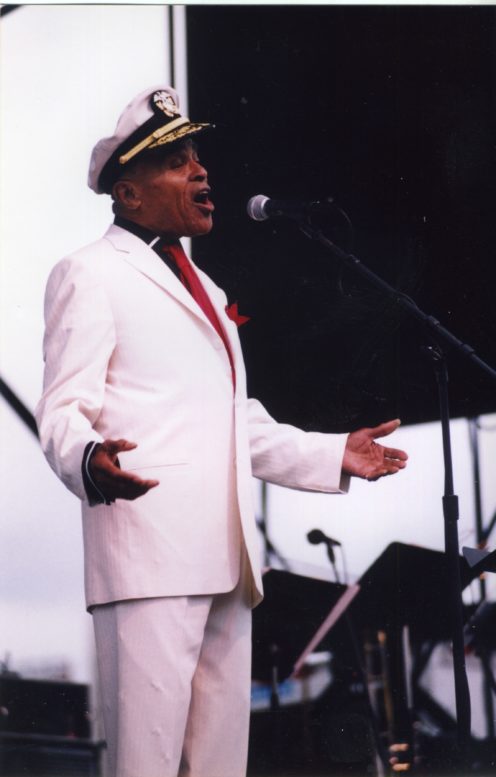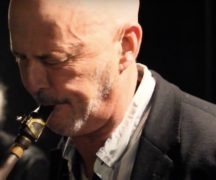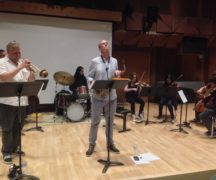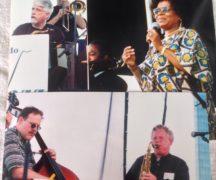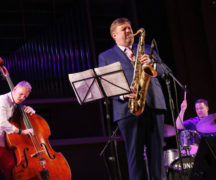By DAVID DUPONT
BG Independent News
Sad to learn this morning that jazz vocalist and lyricist Jon Hendricks has died at 96 on Wednesday (Nov. 22, 2017).
You can easily find the extensive obituaries spelling out his importance in jazz, and his career that extended well into his 90s. He didn’t invent the concept of creating words to go along with jazz instrumentals and improvised solos, but his persistence and longevity meant his work gained the most prominence.
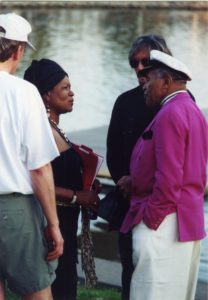
Jon Hendricks (far right) chats with Ramona Collins(left) and Mark Murphy (second from right) back stage at the 2003 Art Tatum Jazz Heritage Jazz Festival
My memories of him date to 2000 when he moved back to Toledo, where he spent his formative years, including singing with legendary pianist Art Tatum. He came back not just to teach, but to preside over the local jazz scene.
He didn’t show up just to sing, but to listen. When the Toledo Museum of Art opened the sculpture garden he was there, always resplendent in a solid, candy colored suit and his captain’s cap. Even when off-stage, Hendricks always had stage presence.
I heard him sing several times on stage at the Art Tatum Jazz Heritage Festival. But I also heard him sing in the audience. During a break at an early festival, he was expounding on the virtues of an evergreen ballad to one of his many fans, leaning over as he illustrated his point with softly sung gem-like phrases.
Let me say this, I really wanted to hear Hendricks sing standards. His voice was warm and gruff, weathered, but never world weary, perfect for the classic lines of the Great American Songbook. As a writer himself, he knew how to get inside a lyric.
He was a great supporter of the festival. When it moved to International Park, he headlined the first year then helped bring in top vocalists to headline, and always seemed to be happy to join them on stage. They seemed thrilled to have him.
My most enduring memory comes from 2009, the year after the Tatum festival gave up the ghost. As it had in the intervals between jazz festival iterations, Murphy’s Place hosted a jazz party.
Of course, Hendricks was there to perform. He was exiting the club after his set, surrounded by a clutch of ladies of a certain age, charming them.
We were outside where a stage had been set up, and some of our regional jazz masters were holding forth. There was already a lot of jazz history on stage. Renell Gonsalves, son of Ellington saxophonist Paul Gonsalves, was on drums. Clifford Murphy, who owned the club with Joan Russell, was on bass. Claude Black, who played with Aretha Franklin until she switched from soulful jazz to soul, was on piano. And Ernie Krivda, one of the music’s greatest tenor saxophonists who eschewed fame to settle in his native Cleveland, was out front. If memory serves me right the band was deep into a classic blowing tune as Hendricks strolled by. He turned his head toward the Krivda’s swirling, Rococo melodies. He listened, then listened more intently, then graciously excused himself.
He walked onto the stage, and with Black’s assistance found a microphone, and added his voice to the jam.
The ebullience and joy that emanated from the stage transformed that parking lot near the Maumee. We were lifted into jazz heaven. This kind of spontaneous artistry, an energy plugged into the rich stream of the music, was like the continuation of jam session that had been in progress for 100 years. I felt I was witnessing the culmination of an era, but also maybe that closing time was near.
Now Hendricks is gone, as are Black and Russell and with them Murphy’s Place, and that night seems all the more prescient. We will never see their likes again.

